In Situ Winter Performance and Annual Energy Assessment of an Ultra-Lightweight, Soil-Free Green Roof in Mediterranean Climate: Comparison with Traditional Roof Insulation
Abstract
1. Introduction
2. Aim and Scope
- to quantify the potential reduction in energy demand resulting from the installation of an ultra-light green roof system on conventional buildings’ roofs;
- to assess the impact of the green roof on inner surface temperature profiles and indoor thermal conditions under real and simulated operating scenarios;
- to simulate how different roof insulation levels influence the thermal performance of a green roof-equipped building envelope.
3. Methodology
3.1. Experimental Phase
3.2. Simulation Phase
4. Results and Discussion
4.1. Experimental Results
4.2. Simulation Results
5. Conclusions
Author Contributions
Funding
Data Availability Statement
Conflicts of Interest
References
- IEA Global Status Report for Buildings and Construction 2019. Available online: https://www.iea.org/reports/global-status-report-for-buildings-and-construction-2019 (accessed on 20 June 2025).
- European Council. The 2030 Climate and Energy Framework. In Climate Change: What the EU is Doing; European Council: Brussels, Belgium, 2025. [Google Scholar]
- European Commission. Renovation Wave. In Energy, Climate Change, Environment; European Commission: Brussels, Belgium, 2025. [Google Scholar]
- Guattari, C.; De Cristo, E.; Evangelisti, L.; Gori, P.; Cureau, R.J.; Fabiani, C.; Pisello, A.L. Thermal Characterization of Building Walls Using an Equivalent Modeling Approach. Energy Build. 2025, 329, 115226. [Google Scholar] [CrossRef]
- De Cristo, E.; Evangelisti, L.; Guattari, C.; De Lieto Vollaro, R. An Experimental Direct Model for the Sky Temperature Evaluation in the Mediterranean Area: A Preliminary Investigation. Energies 2024, 17, 2228. [Google Scholar] [CrossRef]
- Mihalakakou, G.; Souliotis, M.; Papadaki, M.; Menounou, P.; Dimopoulos, P.; Kolokotsa, D.; Paravantis, J.A.; Tsangrassoulis, A.; Panaras, G.; Giannakopoulos, E.; et al. Green Roofs as a Nature-Based Solution for Improving Urban Sustainability: Progress and Perspectives. Renew. Sustain. Energy Rev. 2023, 180, 113306. [Google Scholar] [CrossRef]
- Cuce, P.M.; Cuce, E.; Santamouris, M. Towards Sustainable and Climate-Resilient Cities: Mitigating Urban Heat Islands Through Green Infrastructure. Sustainability 2025, 17, 1303. [Google Scholar] [CrossRef]
- Bovo, M.; Santolini, E.; Barbaresi, A. An Alternative Modular Wooden System for Fast Assembly/Disassembly of Buildings. Buildings 2025, 15, 1196. [Google Scholar] [CrossRef]
- Gholami, M.; Barbaresi, A.; Tassinari, P.; Bovo, M.; Torreggiani, D. A Comparison of Energy and Thermal Performance of Rooftop Greenhouses and Green Roofs in Mediterranean Climate: A Hygrothermal Assessment in WuFi. Energies 2020, 13, 2030. [Google Scholar] [CrossRef]
- Bevilacqua, P. The Effectiveness of Green Roofs in Reducing Building Energy Consumptions across Different Climates. A Summary of Literature Results. Renew. Sustain. Energy Rev. 2021, 151, 111523. [Google Scholar] [CrossRef]
- Bellazzi, A.; Barozzi, B.; Pollastro, M.C.; Meroni, I. Thermal Resistance of Growing Media for Green Roofs: To What Extent Does the Absence of Specific Reference Values Potentially Affect the Global Thermal Resistance of the Green Roof? An Experimental Example. J. Build. Eng. 2020, 28, 101076. [Google Scholar] [CrossRef]
- Kaboré, M.; Bozonnet, E.; Salagnac, P. Building and Urban Cooling Performance Indexes of Wetted and Green Roofs—A Case Study under Current and Future Climates. Energies 2020, 13, 6192. [Google Scholar] [CrossRef]
- Pumo, D.; Alongi, F.; Cannarozzo, M.; Noto, L.V. Climate Adaptive Urban Measures in Mediterranean Areas: Thermal Effectiveness of an Advanced Multilayer Green Roof Installed in Palermo (Italy). Build. Environ. 2023, 243, 110731. [Google Scholar] [CrossRef]
- Maiolo, M.; Pirouz, B.; Bruno, R.; Palermo, S.A.; Arcuri, N.; Piro, P. The Role of the Extensive Green Roofs on Decreasing Building Energy Consumption in the Mediterranean Climate. Sustainability 2020, 12, 359. [Google Scholar] [CrossRef]
- Bevilacqua, P.; Mazzeo, D.; Bruno, R.; Arcuri, N. Experimental Investigation of the Thermal Performances of an Extensive Green Roof in the Mediterranean Area. Energy Build. 2016, 122, 63–79. [Google Scholar] [CrossRef]
- De Cristo, E.; Evangelisti, L.; Barbaro, L.; De Lieto Vollaro, R.; Asdrubali, F. A Systematic Review of Green Roofs’ Thermal and Energy Performance in the Mediterranean Region. Energies 2025, 18, 2517. [Google Scholar] [CrossRef]
- Abu Qadourah, J. Energy Efficiency Evaluation of Green Roofs as a Passive Strategy in the Mediterranean Climate. Results Eng. 2024, 23, 102519. [Google Scholar] [CrossRef]
- Coma, J.; Pérez, G.; Solé, C.; Castell, A.; Cabeza, L.F. Thermal Assessment of Extensive Green Roofs as Passive Tool for Energy Savings in Buildings. Renew Energy 2016, 85, 1106–1115. [Google Scholar] [CrossRef]
- Gomes, M.G.; Silva, C.M.; Valadas, A.S.; Silva, M. Impact of Vegetation, Substrate, and Irrigation on the Energy Performance of Green Roofs in a Mediterranean Climate. Water 2019, 11, 2016. [Google Scholar] [CrossRef]
- Fei, Y.; Fu, D.; Xu, C.; Singh, R.P. Component Design Optimization of Green Roof Substrate Layer Based on the Assessment of Multifunctional Performance. Environ. Res. 2023, 238, 117190. [Google Scholar] [CrossRef]
- Tachibana, D.; Naoki, S.; Kikuchi, S.; Maki, T.; Sato, Y.; Umazume, D.; Imai, K. Trial Application of Factory Rooftop Greening System with Ultra-Lightweight Substrate. AIJ J. Technol. Des. 2010, 16, 411–414. [Google Scholar] [CrossRef]
- Muscas, D.; De Albuquerque Landi, F.F.; Fabiani, C.; Grohmann, D.; Rocchi, L. Zoysia Soil-Less Green Roof’s Performance: A Life Cycle Assessment. Environ. Clim. Technol. 2022, 26, 955–967. [Google Scholar] [CrossRef]
- Cascone, S. Green Roof Design: State of the Art on Technology and Materials. Sustainability 2019, 11, 3020. [Google Scholar] [CrossRef]
- Gagliano, A.; Detommaso, M.; Nocera, F.; Berardi, U. The Adoption of Green Roofs for the Retrofitting of Existing Buildings in the Mediterranean Climate. Int. J. Sustain. Build. Technol. Urban Dev. 2016, 7, 116–129. [Google Scholar] [CrossRef]
- Morakinyo, T.E.; Kalani, K.W.D.; Dahanayake, C.; Ng, E.; Chow, C.L. Temperature and Cooling Demand Reduction by Green-Roof Types in Different Climates and Urban Densities: A Co-Simulation Parametric Study. Energy Build. 2017, 145, 226–237. [Google Scholar] [CrossRef]
- De Cristo, E.; Evangelisti, L.; Battista, G.; Guattari, C.; De Lieto Vollaro, R.; Asdrubali, F. Annual Comparison of the Atmospheric Urban Heat Island in Rome (Italy): An Assessment in Space and Time. Buildings 2023, 13, 2792. [Google Scholar] [CrossRef]
- Lou, S.; Li, D.H.W.; Huang, Y.; Zhou, X.; Xia, D.; Zhao, Y. Change of Climate Data over 37 Years in Hong Kong and the Implications on the Simulation-Based Building Energy Evaluations. Energy Build. 2020, 222, 110062. [Google Scholar] [CrossRef]
- Rady, M.; Muhammad, M.K.I.; Shahid, S. Evolving Typical Meteorological Year (TMY) Data for Building Energy Simulation: A Comprehensive Review of Methods, Challenges, and Future Directions. Adv. Build. Energy Res. 2025, 19, 269–299. [Google Scholar] [CrossRef]
- Magunov, A.N.; Pylnev, M.A.; Lapshinov, B.A. Spectral Pyrometry of Objects with Unknown Emissivities in a Temperature Range of 400–1200 K. Instrum. Exp. Tech. 2014, 57, 86–90. [Google Scholar] [CrossRef]
- TRNSYS 18. Available online: https://www.trnsys.com/ (accessed on 20 June 2025).
- ASHRAE Guideline 14; Measurement of Energy and Demand Savings. ASHRAE: Peachtree Corners, GA, USA, 2002.
- ISO 9869-1. Thermal Insulation—Building Elements—In Situ Measurement of Thermal Resistance and Thermal Transmittance. Available online: https://www.en-standard.eu/une-iso-9869-1-2023-thermal-insulation-building-elements-in-situ-measurement-of-thermal-resistance-and-thermal-transmittance-part-1-heat-flow-meter-method/?gad_source=1&gad_campaignid=22489671069&gbraid=0AAAAAD6CNv-YT_UJBIOFJrPbxsnPJMf4S&gclid=CjwKCAjw49vEBhAVEiwADnMbbOISzN-hq-PFoltpNyaGQ1NZ7B3Rul5Xa4x1EeU7n6gRoC-KXMcZExoCUKsQAvD_BwE (accessed on 9 August 2025).
- Hukseflux Thermal Sensors HFP01 Heat Flux Sensor. Available online: https://www.hukseflux.com/products/heat-flux-sensors/heat-flux-sensors/hfp01-heat-flux-sensor (accessed on 26 November 2024).
- LSI Lastem Sensori per La Misura Della Temperatura Superficiale. Available online: https://lsi-lastem.com/it/prodotti/temperatura-a-contatto/ (accessed on 26 November 2024).
- LSI LASTEM Environmental Monitoring Solutions—Air Temperature. Available online: https://www.lsi-lastem.com/it/prodotti/temperatura-aria-indoor/ (accessed on 30 January 2025).
- Thermal Energy System Specialists, LLC (TESS). TRNSYS Type 785—Green Roof Model Documentation; Thermal Energy System Specialists, LLC (TESS): Madison, WI, USA. Available online: https://www.trnsys.com/tess-libraries/individual-components.php.html (accessed on 12 August 2025).
- Loga, T.; Stein, B.; Diefenbach, N. TABULA Building Typologies in 20 European Countries—Making Energy-Related Features of Residential Building Stocks Comparable. Energy Build. 2016, 132, 4–12. [Google Scholar] [CrossRef]
- American Society of Heating, Refrigerating and Air-Conditioning Engineers (ASHRAE) (Ed.) ASHRAE Handbook—Fundamentals; SI Edition; ASHRAE: Peachtree Corners, GA, USA, 2021. [Google Scholar]
- Chartered Institution of Building Services Engineers (CISBE) (Ed.) Environmental Design (CIBSE Guide A), 7th ed.; Chartered Institution of Building Services Engineers (CISBE): London, UK, 2006; ISBN 1-903287-66-9. [Google Scholar]
- EN 15242:2007; Ventilation for Buildings—Calculation Methods for the Determination of Air Flow Rates in Buildings Including Infiltration. The European Committee for Standardization: Brussels, Belgium, 2007. Available online: https://store.uni.com/en-15242-2007 (accessed on 12 August 2025).
- ISO 6946:2017; Building Components and Building Elements Thermal Resistance and Thermal Transmittance Calculation Methods. The International Organization for Standardization: Geneva, Switzerland, 2017.
- ISO 7730; Ergonomics of the Thermal Environment—Analytical Determination and Interpretation of Thermal Comfort Using Calculation of the PMV and PPD Indices and Local Thermal Comfort Criteria. The International Organization for Standardization: Geneva, Switzerland, 2005.
- ASHRAE Standard 55; Thermal Environmental Conditions for Human Occupancy. ASHRAE: Peachtree Corners, GA, USA, 2023. Available online: https://www.ashrae.org/technical-resources/bookstore/standard-55-thermal-environmental-conditions-for-human-occupancy (accessed on 27 July 2025).
- Bienvenido-Huertas, D.; Moyano, J.; Marín, D.; Fresco-Contreras, R. Review of in Situ Methods for Assessing the Thermal Transmittance of Walls. Renew. Sustain. Energy Rev. 2019, 102, 356–371. [Google Scholar] [CrossRef]

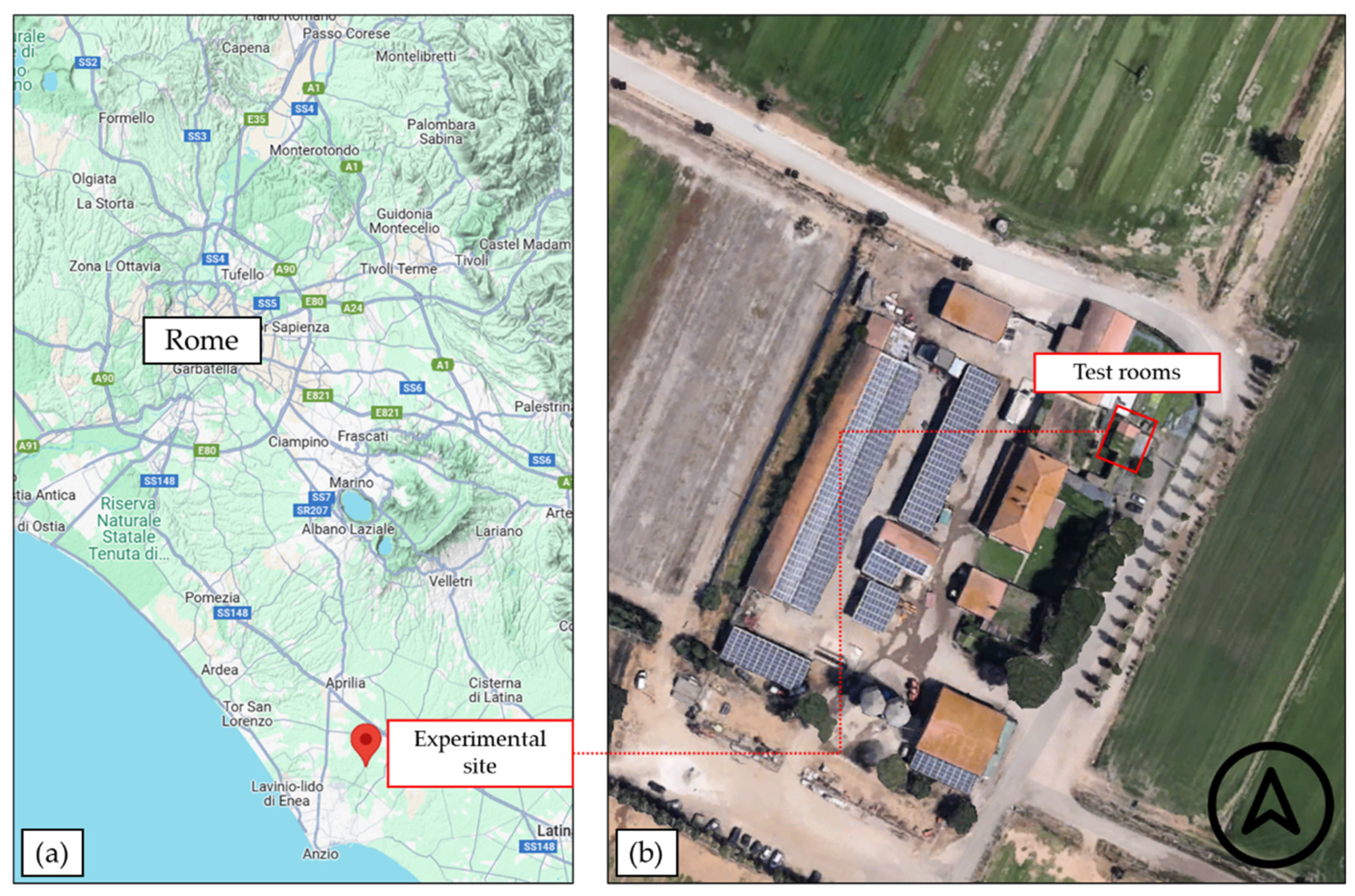
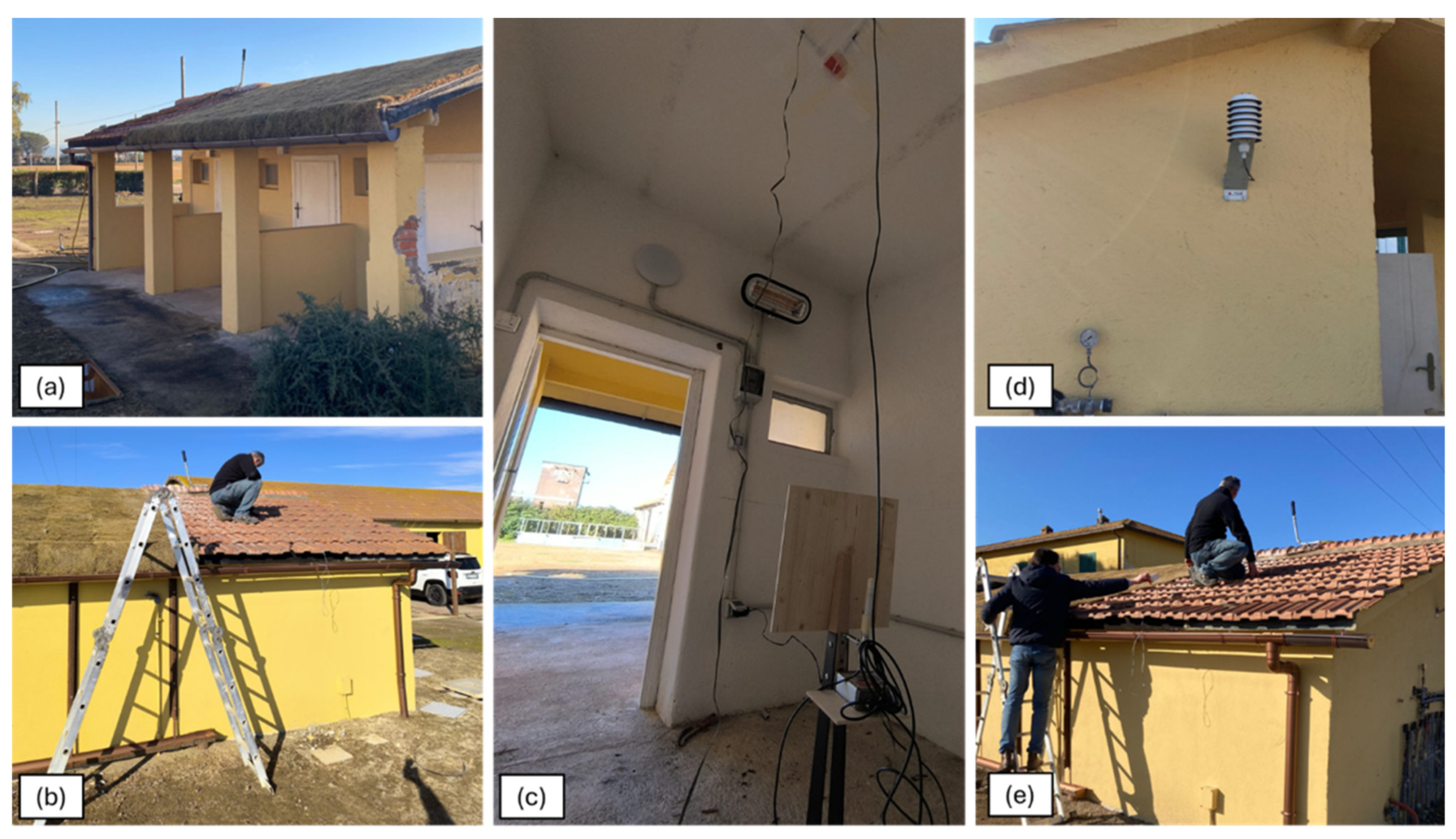
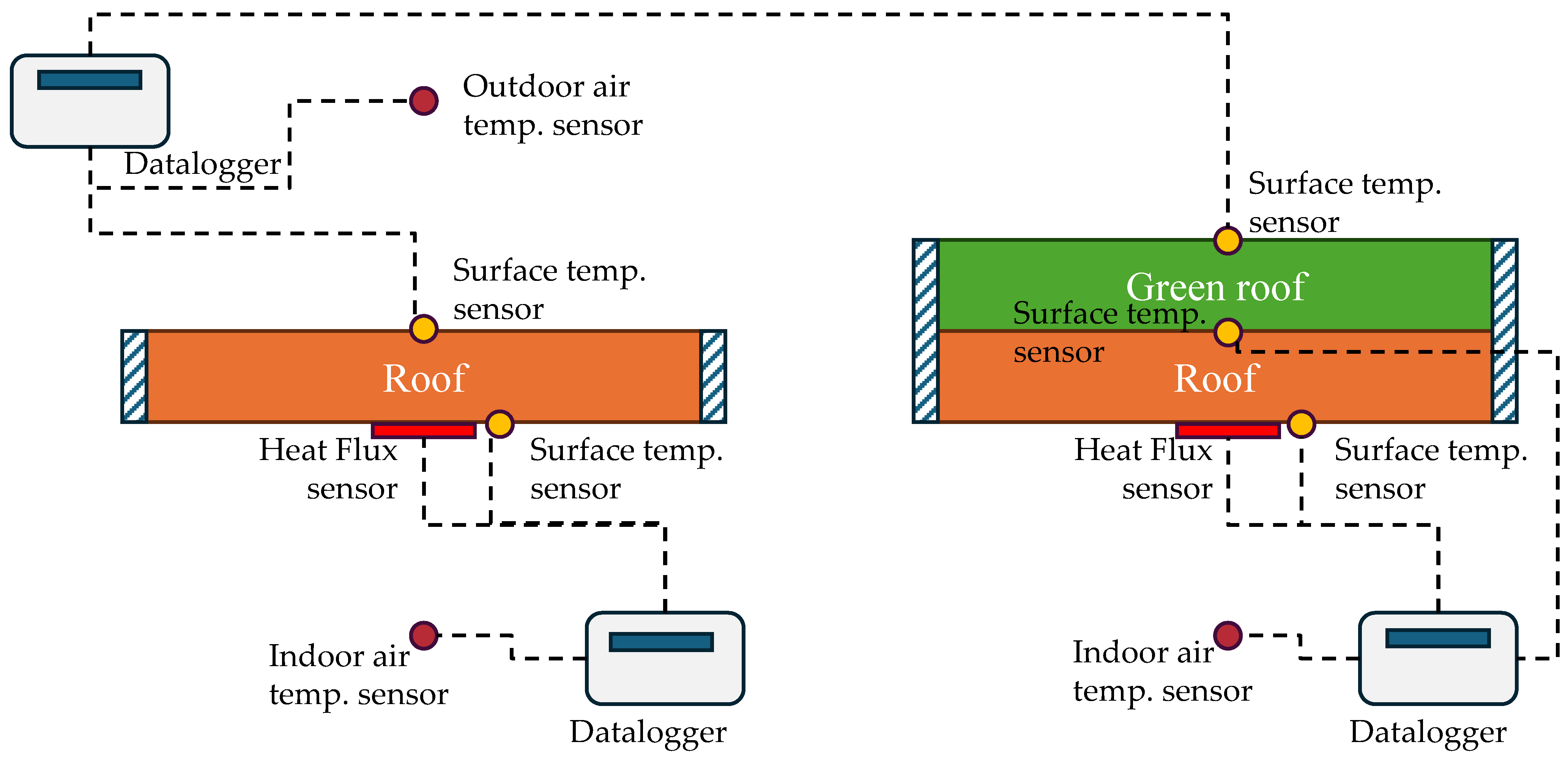


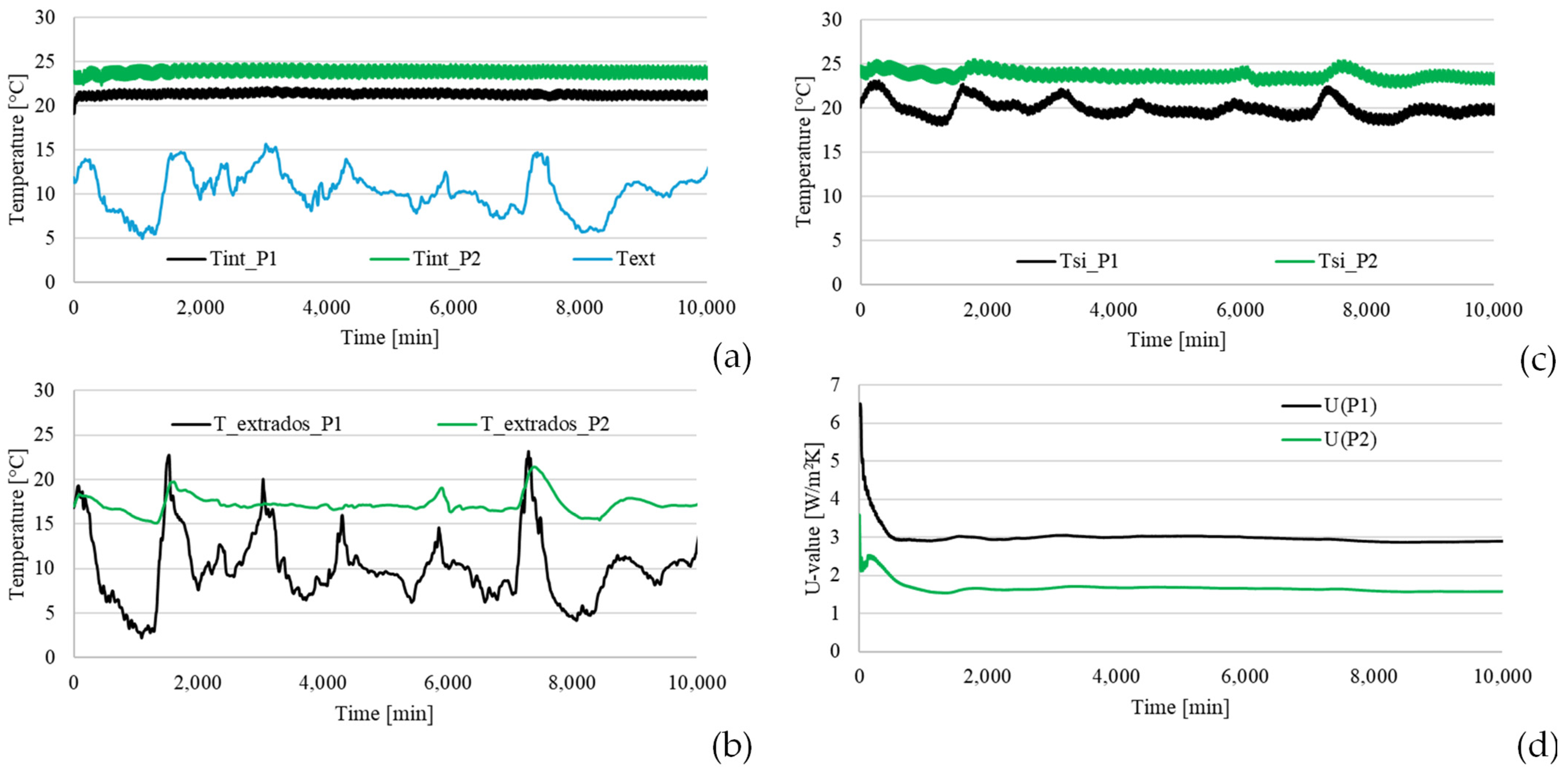
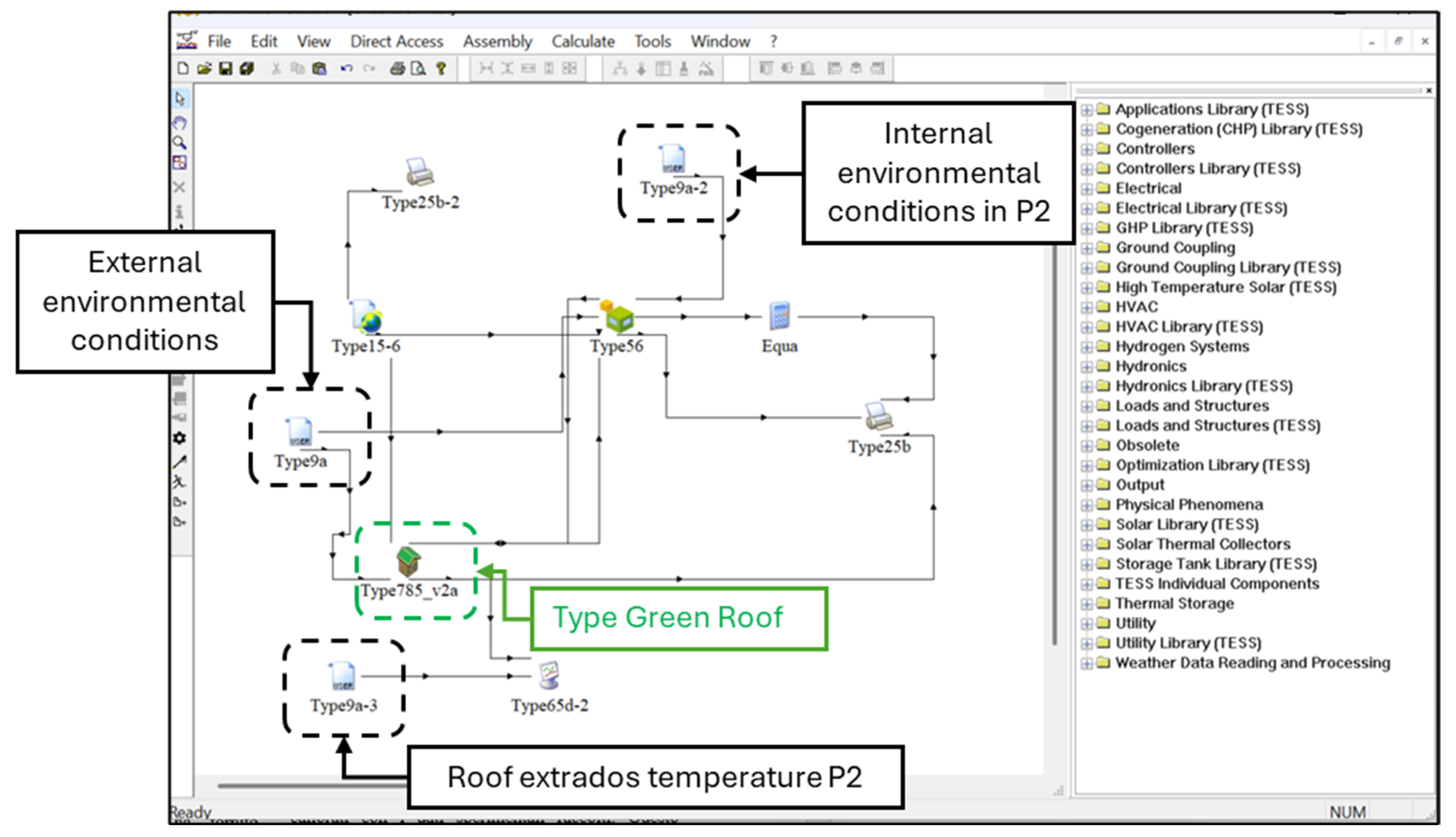
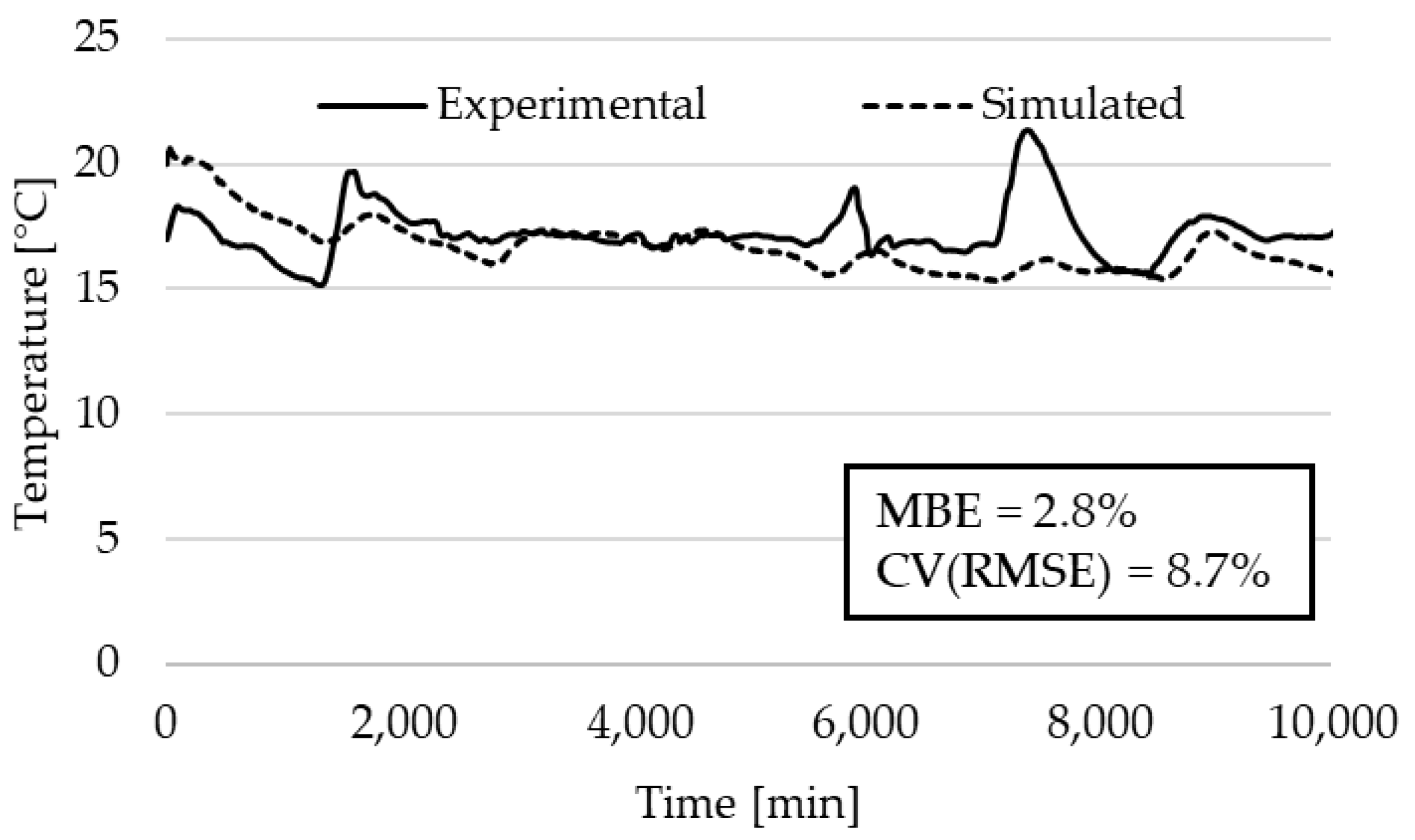
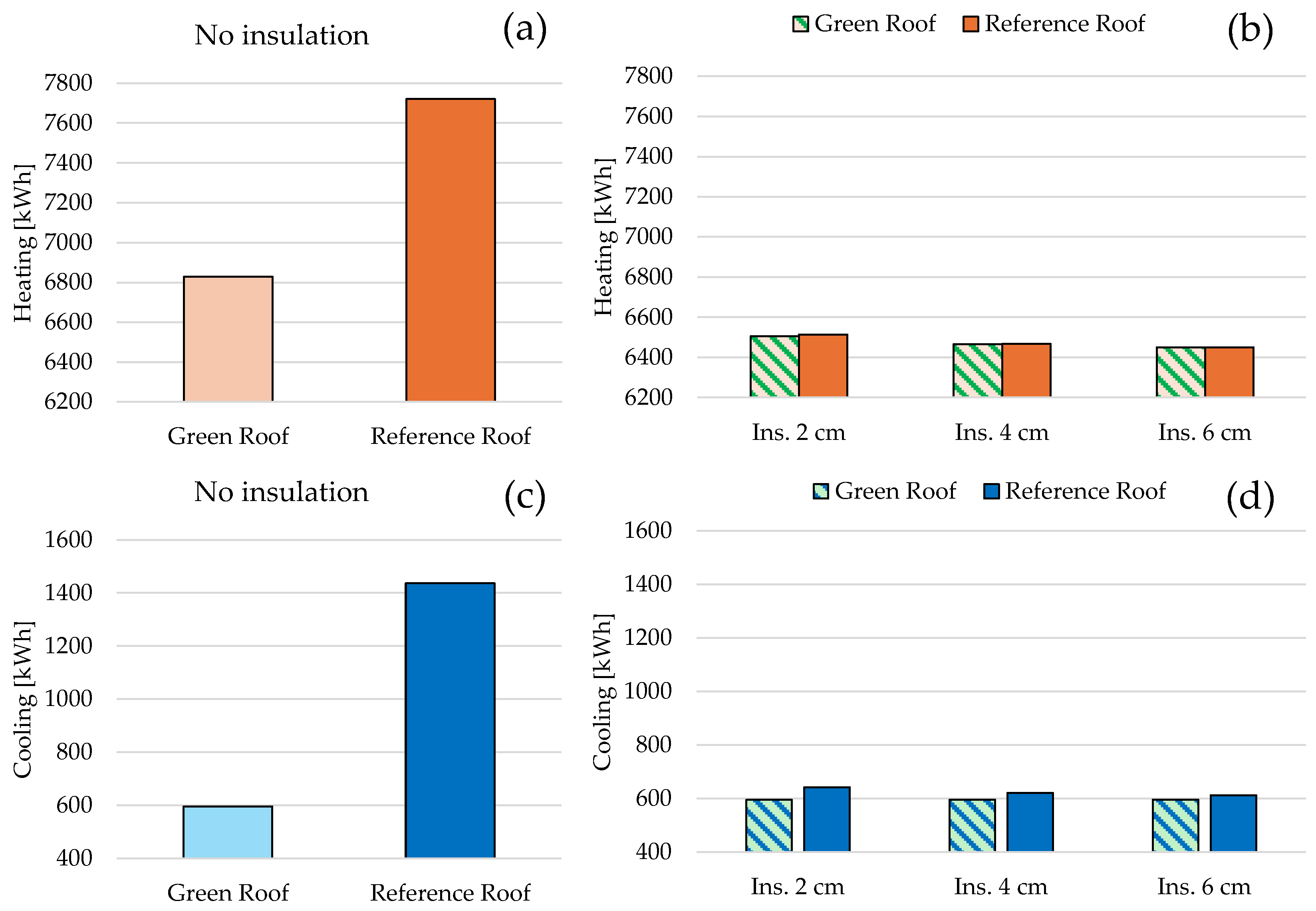
| Component | Material | Thickness [m] | Thermal Conductivity [W/mK] | Specific Heat Capacity [J/kgK] | Mass Density [kg/m3] |
|---|---|---|---|---|---|
| Walls | Plaster | 0.020 | 0.870 | 1000 | 1600 |
| Solid brick | 0.200 | 0.800 | 840 | 1600 | |
| Plaster | 0.020 | 0.870 | 1000 | 1600 | |
| Roof | Plaster | 0.015 | 0.870 | 1000 | 1600 |
| Hollow clay block | 0.120 | 0.400 | 840 | 800 | |
| Concrete | 0.040 | 1.400 | 1000 | 2200 | |
| Basement | Concrete | 0.300 | 1.400 | 1000 | 2200 |
| U-Value | P1 | Criterion Satisfied | P2 | Criterion Satisfied |
|---|---|---|---|---|
| U (last value) | 2.897 | ☑ | 1.588 | ☑ |
| U (24 h before) | 2.867 | ☑ (1.0%) | 1.579 | ☑ (0.6%) |
| U (first2/3; last2/3) | 2.957; 3.027 | ☑ (−2.3%) | 1.654; 1.719 | ☑ (−3.8%) |
| Heating | No Insulation [kWh/m2] | Insulation 2 cm [kWh/m2] | Insulation 4 cm [kWh/m2] | Insulation 6 cm [kWh/m2] |
|---|---|---|---|---|
| Green Roof | 189.68 | 180.68 | 179.59 | 179.16 |
| Reference Roof | 214.50 | 180.93 | 179.62 | 179.15 |
| Cooling | No Insulation [kWh/m2] | Insulation 2 cm [kWh/m2] | Insulation 4 cm [kWh/m2] | Insulation 6 cm [kWh/m2] |
|---|---|---|---|---|
| Green Roof | 16.55 | 16.52 | 16.54 | 16.55 |
| Reference Roof | 39.90 | 17.82 | 17.22 | 17.00 |
| Month | ΔMRT [°C] | ΔTOP [°C] | ΔPMV [-] | ΔPPD [%] |
|---|---|---|---|---|
| January | 0.64 | 0.32 | 0.06 | −1.37 |
| February | 0.68 | 0.34 | 0.06 | −1.61 |
| March | 0.12 | 0.02 | 0.00 | −0.44 |
| April | −0.40 | −0.44 | −0.10 | 1.30 |
| May | −0.73 | −0.66 | −0.15 | −1.17 |
| June | −0.85 | −0.57 | −0.16 | −0.94 |
| July | −0.99 | −0.52 | −0.15 | −2.94 |
| August | −0.92 | −0.50 | −0.14 | −2.32 |
| September | −0.78 | −0.75 | −0.22 | 4.47 |
| October | −0.29 | −0.30 | −0.07 | 1.63 |
| November | 0.39 | 0.20 | 0.03 | −0.75 |
| December | 0.70 | 0.35 | 0.06 | −1.56 |
| Insulation | 2 cm | 2 cm | 2 cm | 2 cm | 4 cm | 4 cm | 4 cm | 4 cm | 6 cm | 6 cm | 6 cm | 6 cm |
|---|---|---|---|---|---|---|---|---|---|---|---|---|
| Month | ΔMRT [°C] | ΔTOP [°C] | ΔPMV [-] | ΔPPD [%] | ΔMRT [°C] | ΔTOP [°C] | ΔPMV [-] | ΔPPD [%] | ΔMRT [°C] | ΔTOP [°C] | ΔPMV [-] | ΔPPD [%] |
| January | 0.03 | 0.01 | 0.00 | −0.05 | 0.01 | 0.01 | 0.00 | −0.02 | 0.01 | 0.00 | 0.00 | −0.01 |
| February | 0.03 | 0.01 | 0.00 | −0.06 | 0.01 | 0.01 | 0.00 | −0.03 | 0.01 | 0.00 | 0.00 | −0.02 |
| March | −0.01 | −0.01 | 0.00 | 0.01 | −0.01 | 0.00 | 0.00 | 0.01 | −0.01 | 0.00 | 0.00 | 0.01 |
| April | −0.04 | −0.03 | −0.01 | 0.19 | −0.02 | −0.02 | 0.00 | 0.11 | −0.02 | −0.01 | 0.00 | 0.07 |
| May | −0.09 | −0.09 | −0.02 | 0.15 | −0.05 | −0.05 | −0.01 | 0.08 | −0.03 | −0.03 | −0.01 | 0.06 |
| June | −0.11 | −0.09 | −0.03 | 0.42 | −0.06 | −0.05 | −0.01 | 0.23 | −0.04 | −0.03 | −0.01 | 0.16 |
| July | −0.11 | −0.08 | −0.02 | −0.03 | −0.06 | −0.04 | −0.01 | −0.01 | −0.04 | −0.03 | −0.01 | 0.00 |
| August | −0.11 | −0.08 | −0.02 | 0.02 | −0.06 | −0.04 | −0.01 | 0.02 | −0.04 | −0.03 | −0.01 | 0.01 |
| September | −0.08 | −0.07 | −0.02 | 0.81 | −0.04 | −0.04 | −0.01 | 0.43 | −0.03 | −0.03 | −0.01 | 0.29 |
| October | −0.03 | −0.02 | 0.00 | 0.12 | −0.01 | −0.01 | 0.00 | 0.07 | −0.01 | −0.01 | 0.00 | 0.04 |
| November | 0.01 | 0.01 | 0.00 | −0.02 | 0.00 | 0.00 | 0.00 | −0.01 | 0.00 | 0.00 | 0.00 | 0.00 |
| December | 0.03 | 0.01 | 0.00 | −0.06 | 0.01 | 0.01 | 0.00 | −0.03 | 0.01 | 0.00 | 0.00 | −0.02 |
Disclaimer/Publisher’s Note: The statements, opinions and data contained in all publications are solely those of the individual author(s) and contributor(s) and not of MDPI and/or the editor(s). MDPI and/or the editor(s) disclaim responsibility for any injury to people or property resulting from any ideas, methods, instructions or products referred to in the content. |
© 2025 by the authors. Licensee MDPI, Basel, Switzerland. This article is an open access article distributed under the terms and conditions of the Creative Commons Attribution (CC BY) license (https://creativecommons.org/licenses/by/4.0/).
Share and Cite
Evangelisti, L.; De Cristo, E.; De Lieto Vollaro, R. In Situ Winter Performance and Annual Energy Assessment of an Ultra-Lightweight, Soil-Free Green Roof in Mediterranean Climate: Comparison with Traditional Roof Insulation. Energies 2025, 18, 4581. https://doi.org/10.3390/en18174581
Evangelisti L, De Cristo E, De Lieto Vollaro R. In Situ Winter Performance and Annual Energy Assessment of an Ultra-Lightweight, Soil-Free Green Roof in Mediterranean Climate: Comparison with Traditional Roof Insulation. Energies. 2025; 18(17):4581. https://doi.org/10.3390/en18174581
Chicago/Turabian StyleEvangelisti, Luca, Edoardo De Cristo, and Roberto De Lieto Vollaro. 2025. "In Situ Winter Performance and Annual Energy Assessment of an Ultra-Lightweight, Soil-Free Green Roof in Mediterranean Climate: Comparison with Traditional Roof Insulation" Energies 18, no. 17: 4581. https://doi.org/10.3390/en18174581
APA StyleEvangelisti, L., De Cristo, E., & De Lieto Vollaro, R. (2025). In Situ Winter Performance and Annual Energy Assessment of an Ultra-Lightweight, Soil-Free Green Roof in Mediterranean Climate: Comparison with Traditional Roof Insulation. Energies, 18(17), 4581. https://doi.org/10.3390/en18174581









